Employing native English-Speaking teachers for English courses: Stakeholders’ perceptions
Native English-speaking teachers (NESTs) are needed to teach English at
many universities in Vietnam because they are commonly regarded as
models for communication in English. Yet, does this rationale correspond
with the views of students who enrolled in high-quality programmes and
administrators (departmental and functional leaders who are administering
the programmes)? This article reports on research carried out with
university students and leaders at University A (A pseudonym was used for
the researched institution) in Vietnam, exploring stakeholders’ (specifically
students and institutional leaders) perceptions of employing NESTs to teach
English speaking skills. Data were collected through an open-ended
questionnaire with 65 students and in-depth interviews with 40 students
(those who participated in the interviews also responded to the
questionnaire) and interviews with four leaders. Data were thematically
analysed through an inductive approach. The major factors that could help
NESTs meet students’ expectations were their teaching methods and the
extent to which they could interact with students together with
communicative competence and cultural knowledge. Students viewed NESTs
as models for communicating in English but also had difficulty in
understanding these teachers when there were differences in culture and
language uses. It was indicated by leaders that NESTs are employed as a
motivating and diversifying source of teaching staff and marketing
communication figures for the institution. The findings suggest that to meet
students’ expectations, it is necessary that NESTs improve their teaching
methods, receive training and be under a screening procedure of recruitment
and quality assurance. Employing NESTs is a trend in Vietnam, but quality
procedures need to be established for assuring that these NESTs comply with
the quality expectation at the institution
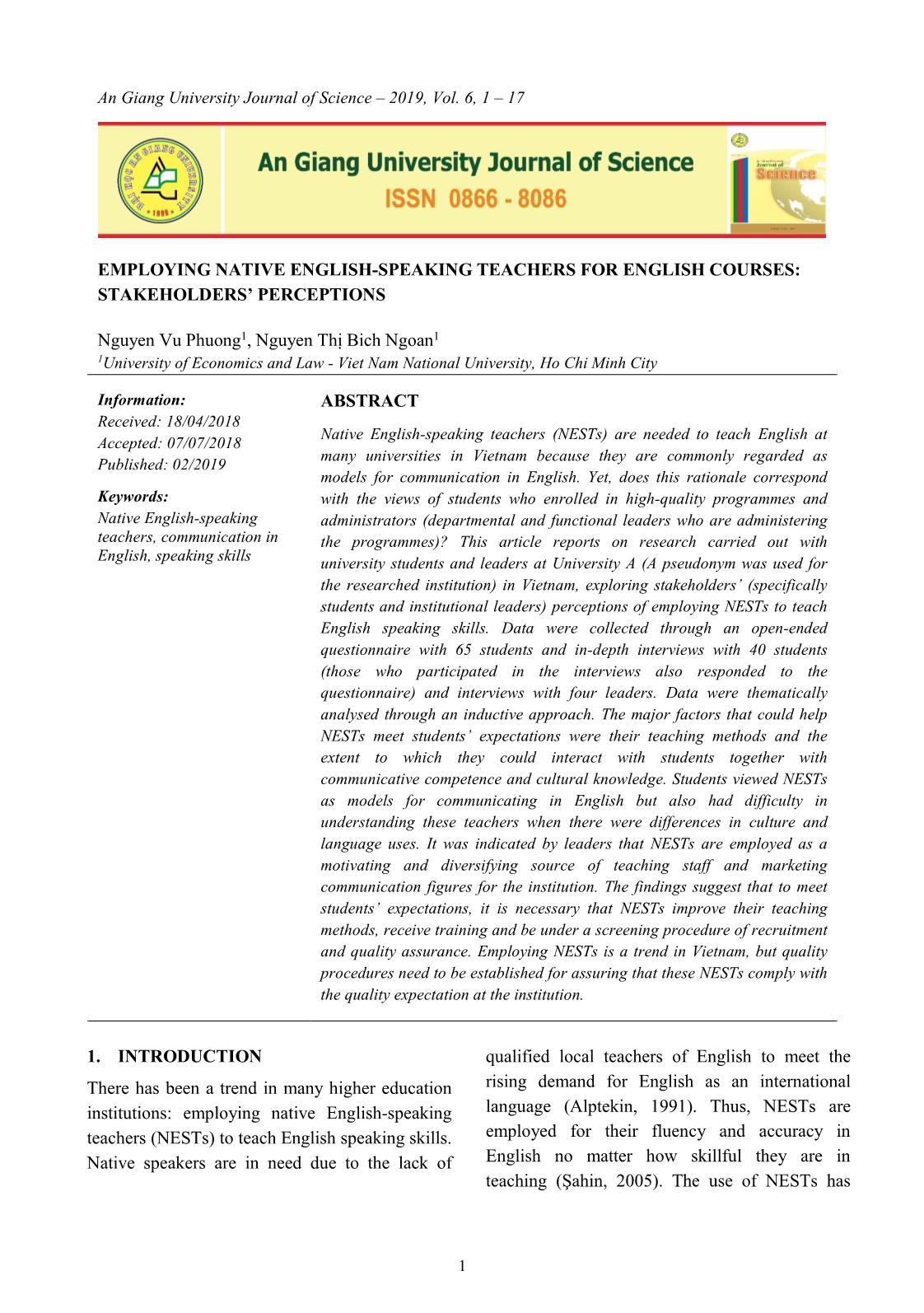
Trang 1
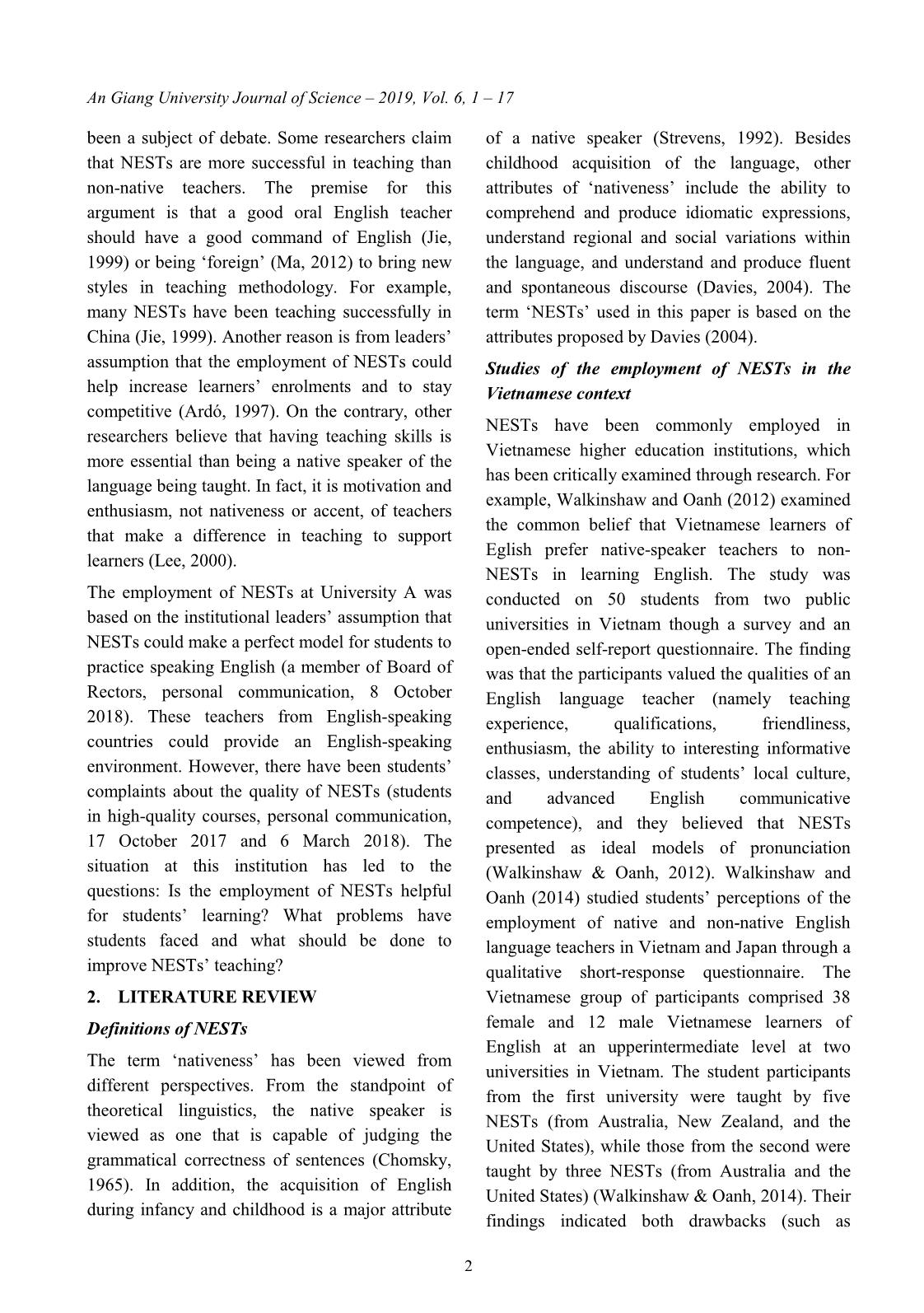
Trang 2
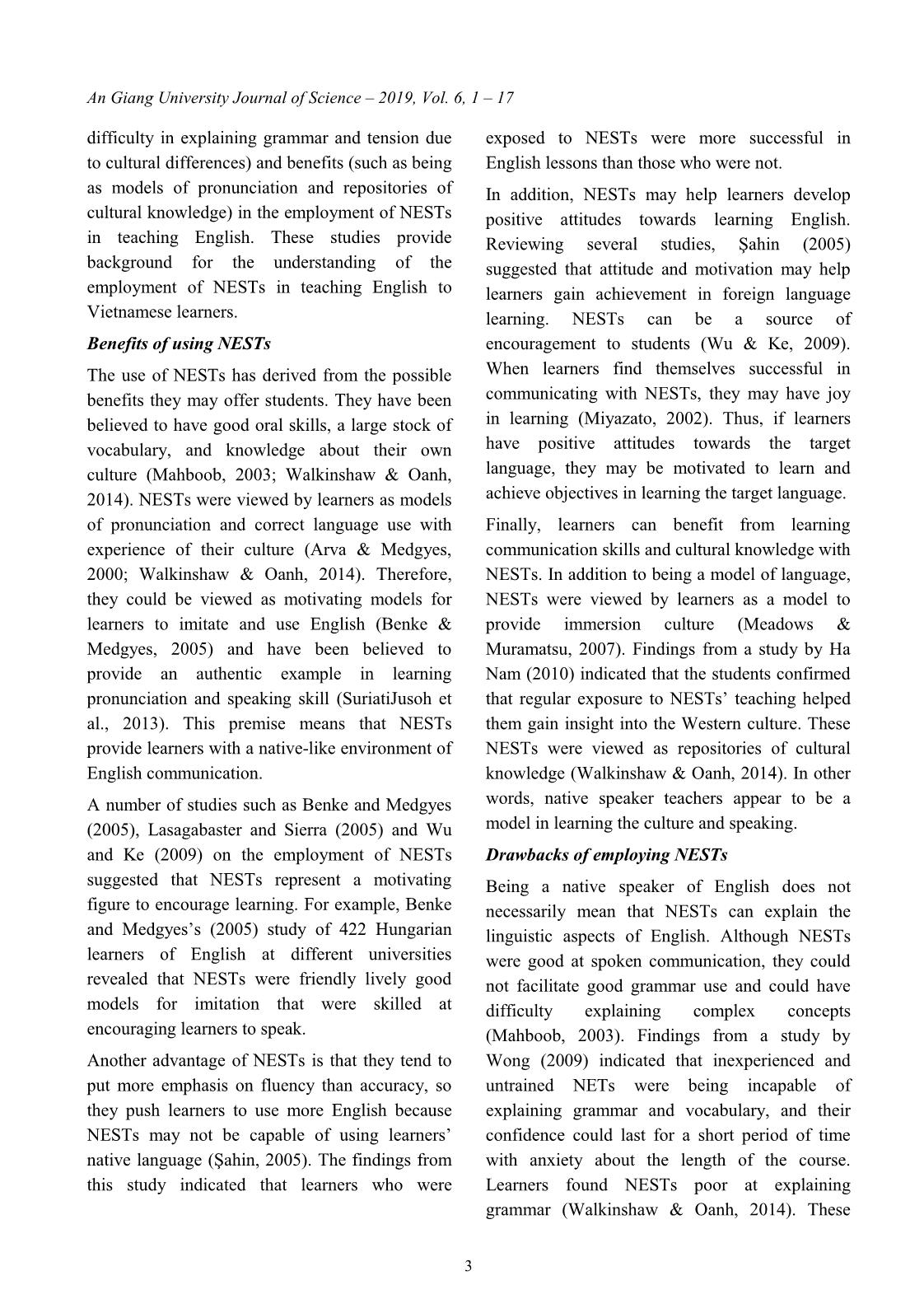
Trang 3
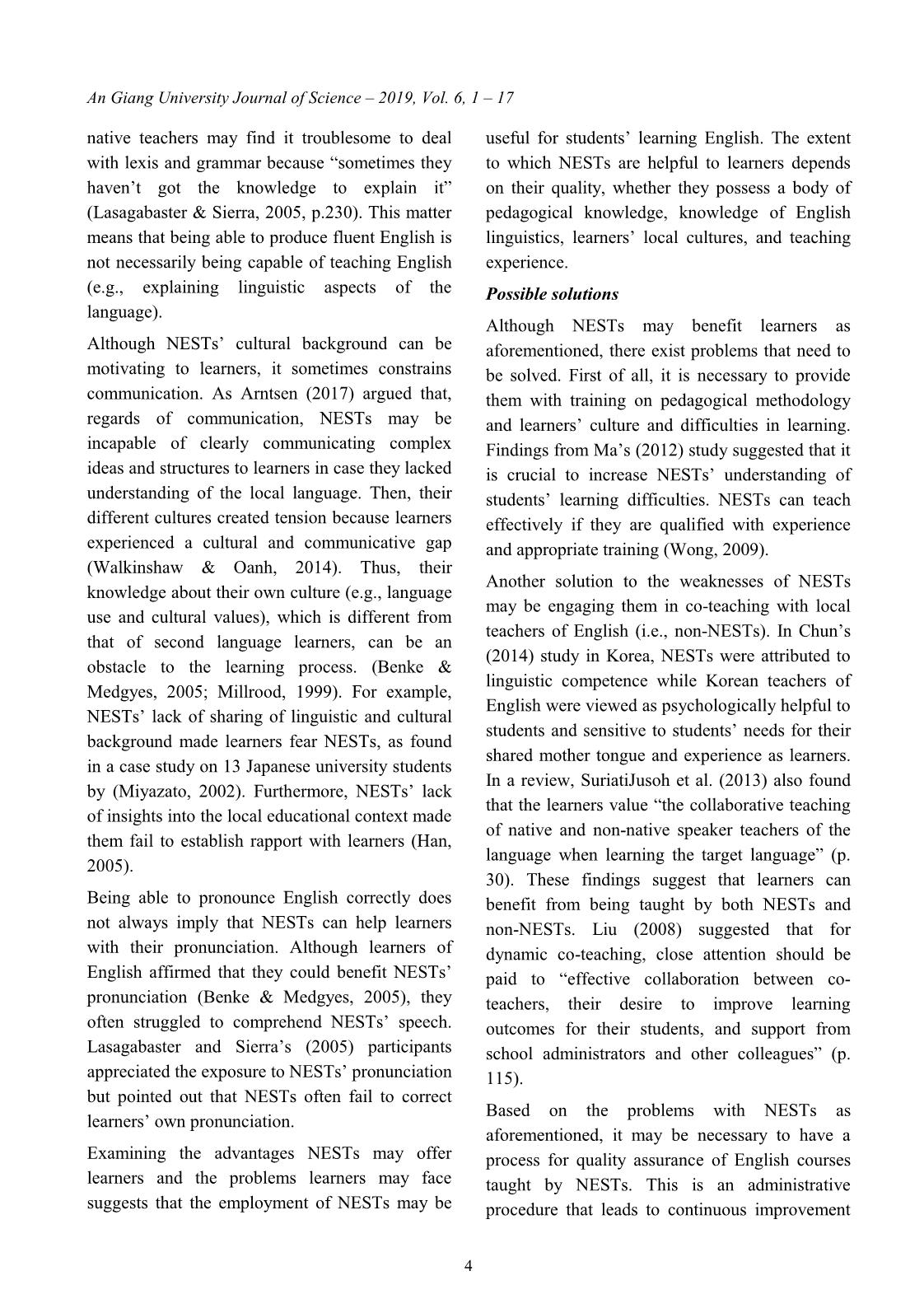
Trang 4
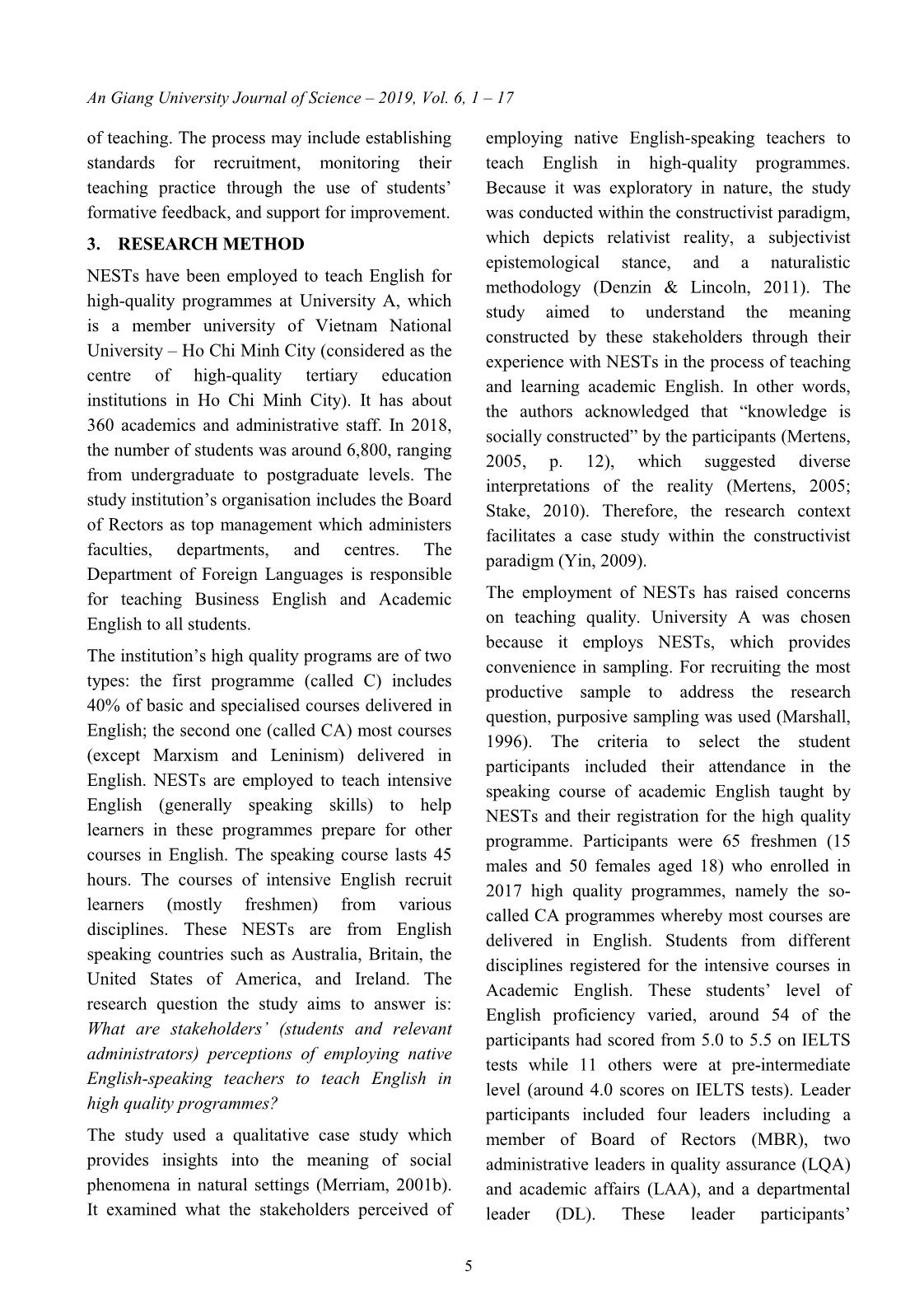
Trang 5
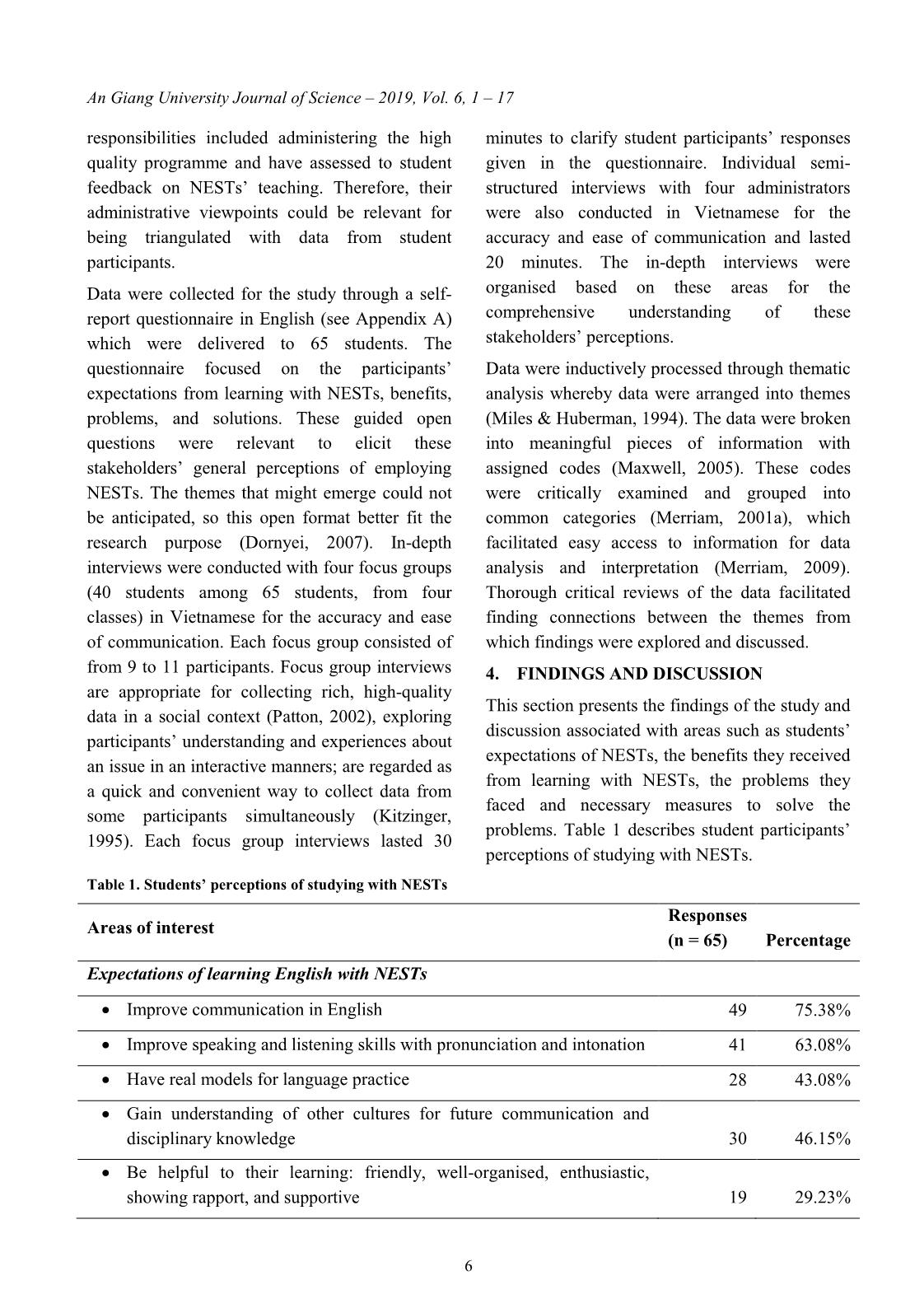
Trang 6
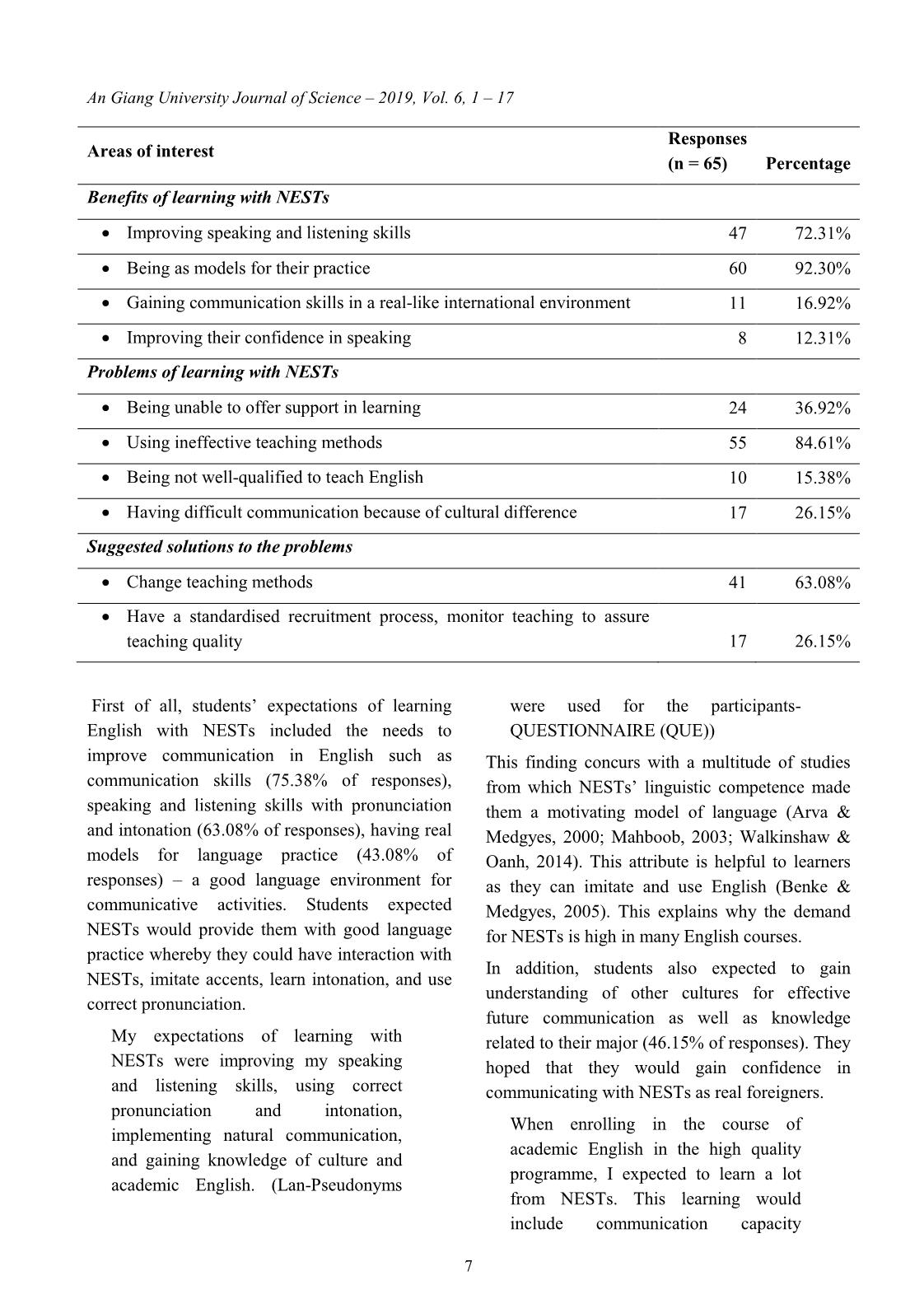
Trang 7
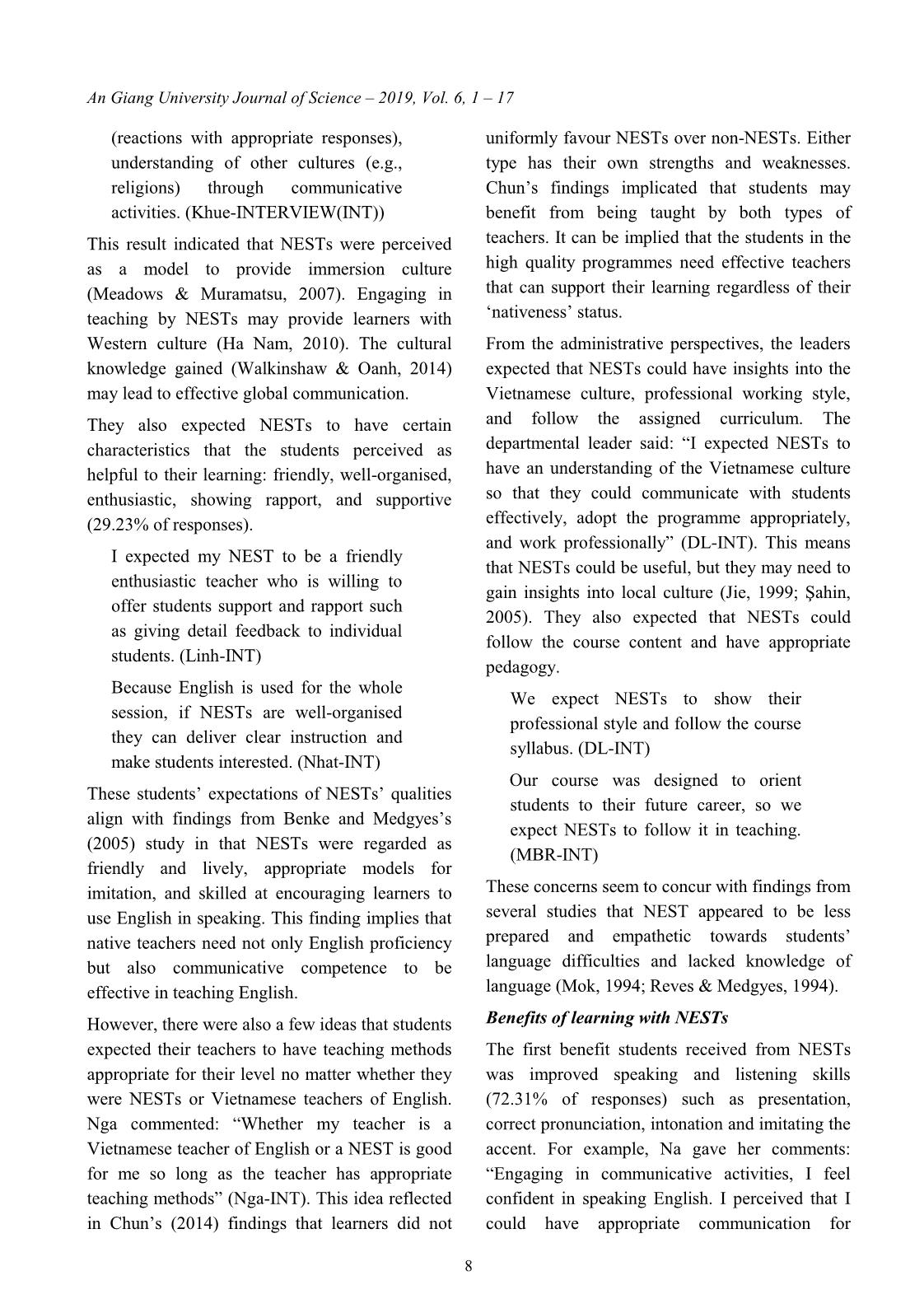
Trang 8
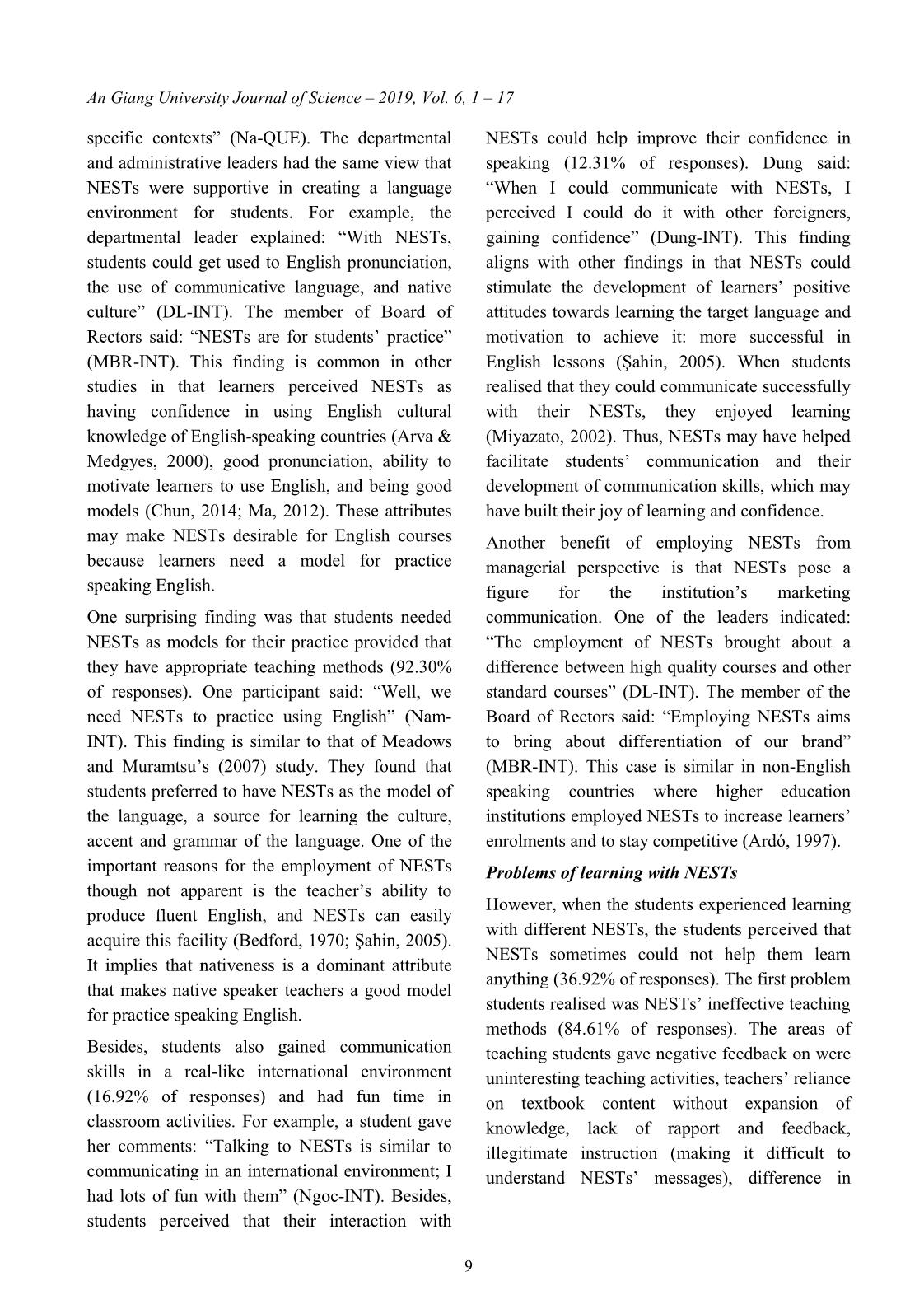
Trang 9
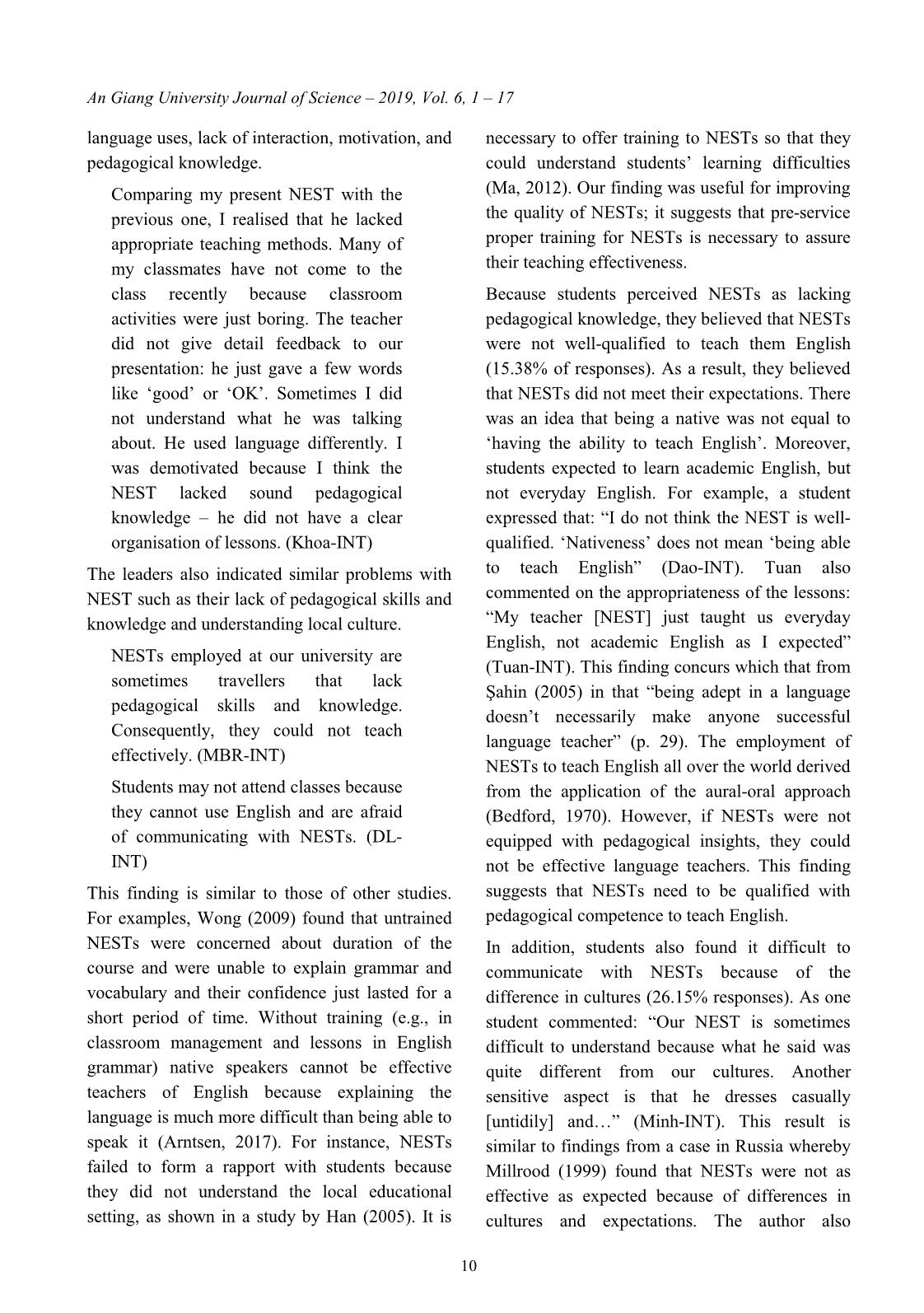
Trang 10
Tải về để xem bản đầy đủ
Tóm tắt nội dung tài liệu: Employing native English-Speaking teachers for English courses: Stakeholders’ perceptions
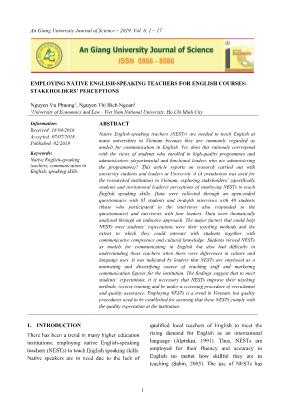
nsider having long-term contracts with them through recruitment policies. All the leader participants have the same view on the issue: It is necessary to consider recruiting NESTs as tenured teaching staff so that they become responsible and committed to teaching for long-term interest. It is possible to assign them to teaching a complete course. Every semester, the staffing of NESTs keeps changing, so new NESTs do not know about our organisational culture. (DL-INT) Long-term contracts may make NESTs responsible for students’ learning. It is also crucial to assign them more teaching hours. (LAA-INT) These leaders agreed that employing NESTs is a way to market the institution’s brand, especially the high quality programmes. 5. CONCLUSION The employment of NESTs for high quality programmes at University A was grounded by students’ and leaders’ perceptions of their linguistic competence. In fact, native speaker teachers were necessary for students to improve English. This presents a high demand of NESTs for English courses at the university. NESTs represent motivating models of pronunciation, fluency, and communication that helped improve students’ speaking and listening skills. These teachers provided conditions for students’ practice provided that they have appropriate teaching methods together with experience. As a good example of using natural English, these teachers may encourage communication and the development of communicative competence. However, the concerns of using NESTs are associated with their teaching methodology. When NESTs lacked sound teaching methods, they may fail to engage students in learning. Their cultural background can be a source for students to learn how to communicate internationally, but it also restricts communication and inhibits students’ understanding of messages delivered due to the lack of shared values. Thus, several solutions to address the concerns may include offering NESTs proper training, engaging them in co-teaching with local English teachers, and establishing a standardised procedure for recruitment and teaching improvement. The findings from this study have posed some areas for further examination of the issue being addressed. These may include the relationship An Giang University Journal of Science – 2019, Vol. 6, 1 – 17 13 between students’ learning and the quality of NESTs, the possible implementation of co- teaching for high quality programmes, and the effectiveness of NESTs’ teaching and student learning outcomes. Another issue to consider is investigating the problem from the NESTs’ perspectives. Acknowledgement The authors acknowledge the students and the leaders that kindly agreed to participate in this study and share their experiences in the interviews. REFERENCES Alptekin, C. (1991). A look into the use of native speaker teachers in EFL programs. TEFL Turkey Reporter, 1, 5-8. Ardó, Z. (1997). The very heart of English? On culture, language, and the native speaker’s head. TESL-EJ, 1(4), 2. Arntsen, T. (2017). ESL Controversy: Native speakers and non-native speakers can both succeed as ESL teachers. native-speaker-vs-non-native.html Arva, V., & Medgyes, P. (2000). Native and non- native teachers in the classroom. System, 28, 355-372. Bedford, R. C. (1970). The role and function of the native teacher. English Teaching Forum, 8(5), 7-11. Benke, E., & Medgyes, P. (2005). Differences in teaching behaviour between native and nonnative speaker teachers: As seen by the learners. In E. Llurda (Ed.), Nonnative language teachers: Perceptions, challenges and contributions to the profession (pp. 195- 215). New York, NY: Springer. Chomsky, N. (1965). Aspects of the theory of syntax. Cambridge: MIT Press. Chun, S. Y. (2014). EFL learners' beliefs about native and non-native English-speaking teachers: perceived strengths, weaknesses, and preferences. Journal of Multilingual and Multicultural Development, 35(6), 563-579. Davies, A. (2004). The native speaker in applied linguistics. In A. Davies & C. Elder (Eds.), The handbook of applied linguistics (pp. 431- 450). Oxford, UK: Blackwell. Denzin, N. K., & Lincoln, Y. S. (2011). The SAGE handbook of qualitative research (4th ed.). Thousand Oak, CA: Sage. Dornyei, Z. (2007). Research methods in applied linguistics. Oxford, UK: Oxford University Press. Ha Nam, H. (2010). The pedagogy and its effectiveness among native and non-native speaking teachers in the Korean EFL context. ( Unpublished doctoral thesis ), University of Buffalo, State University of New York. Han, S. A. (2005). Good teachers know where to scratch when learn- ers feel itchy: Korean learners’ views of native-speaking teachers of English. Australian Journal of Education, 49, 197-213. Jie, Z. (1999). How can a Chinese teacher of English succeed in oral English classes? The Internet TESL Journal, 5(7). Kitzinger, J. (1995). Qualitative Research: Introducing focus groups. British Medical Journal, 311, 299. Lasagabaster, D., & Sierra, J. M. (2005). What do students think about the pros and cons of having a native-speaker teacher? In E. Llurda (Ed.), Nonnative language teachers: Perceptions, challenges and contributions to the profession (pp. 217-242). New York, NY: Springer. Lee, I. (2000). Can a non-native English speaker be a good English teacher? TESOL Matters, 10(1), 19. Liu, L. (2008). Co-teaching between native and non-native English teachers: An exploration of An Giang University Journal of Science – 2019, Vol. 6, 1 – 17 14 co-teaching models and strategies in the Chinese primary school context. Reflections on English Language Teaching, 7(2), 103–118. Ma, L. P. F. (2012). Perceived teaching behaviour of native and non-native English speaking teachers in Hong Kong: Are there any differences? Hong Kong Journal of Applied Linguistics, 14(1), 89–108. Mahboob, A. (2003). Status of nonnative English- speaking teach- ers in the United States. (Unpublished doctoral dissertation), Indiana University, Indiana University, Bloomington. . Marshall, M. N. (1996). Sampling for qualitative research. Family Practice, 13(6), 522-525. Maxwell, J. A. (2005). Qualitative research design: An interative approach (2nd ed.). Thousand Oaks, CA: SAGE. Meadows, B., & Muramatsu, Y. (2007). Native speaker or non-native speaker teacher?: A report of student preferences in four different foreign language classrooms. Arizona Working Papers in SLA & Teaching, 14, 95-109. Merriam, S. B. (2001a). Qualitative research and case study applications in education (2nd ed.). San Francisco, CA: Jossey-Bass. Merriam, S. B. (2001b). Qualitative research and case study applications in education: Revised and expanded from case study research in education. San Francisco, CA: Jossey-Bass. Merriam, S. B. (2009). Qualitative research: A guide to design and implementation. San Francisco, CA: Jossey-Bass. Mertens, D. M. (2005). Research and evaluation in education and psychology: Integrating diversity with quantitative, qualitative, and mixed methods. Thousand Oaks, CA: SAGE. Miles, M. B., & Huberman, A. M. (1994). Qualitative data analysis: An expanded sourcebook (2nd ed.). Thousand Oaks, CA: SAGE. Millrood, R. (1999). How native English speakers can be better English teachers in Russia. The Internet TESL Journal, 5(1). Miyazato, K. (2002). Anxiety or admiration?: Japanese EFL learner's perceptions of native speaker teachers' classes. Paper presented at the JALT Conference 2002. Mok, W. (1994). Reflecting on reflections: A case study of experienced and inexperienced ESL teachers. System, 22(1), 93-111. Patton, M. Q. (2002). Qualitative evaluation and research methods (3rd ed.). Thousand Oaks, CA: Sage. Reves, T., & Medgyes, P. (1994). The non-native English speaking EFL/ESL teacher‟s self- image: An international survey. System, 22(3), 353-367. Şahin, İ. (2005). The effect of native speaker teachers of English on the attitudes and achievement of learners. Journal of Language and Linguistic Studies, 1(1), 29-42. Stake, R. E. (2010). Qualitative research: Studying how things work. New York: The Guilford Press. Strevens, P. (1992). English as an international language: Direction in the 1990s. In B. B. Kachru (Ed.), The other tongue: English across cultures (2nd ed., pp. 27-47). Urbana, IL: University of Illinois Press. SuriatiJusoh, F., Alias, N., Siraj, S., Witt, D. D., Hussin, Z., & Darusalam, G. (2013). Research and trends in the studies of native & non- native speaker teachers of languages: A review on selected researches and theses. The Malaysian Online Journal of Educational Science, 1(1), 30-42. Walkinshaw, I., & Oanh, D. T. H. (2012). Native- and non-native speaking English teachers in Vietnam: Weighing the benefits. TESL-EJ, 16(3), 1-17. An Giang University Journal of Science – 2019, Vol. 6, 1 – 17 15 Walkinshaw, I., & Oanh, D. T. H. (2014). Native and non-native English language teachers: Student perceptions in Vietnam and Japan. SAGE Open, 1-9. Wong, C.-Y. (2009). Are native speakers “good” language instructors? A case study of untrained ESL tutors. ARECLS, 6, 122-140. Wu, K. H., & Ke, C. (2009). Haunting native speakerism? Students’ perceptions toward native speaking English teachers in Taiwan. English Language Teaching, 2(3), 44-52. Yin, R. K. (2009). Case study research: Design and methods (4th ed.). Thousand Oaks, CA: SAGE. An Giang University Journal of Science – 2019, Vol. 6, 1 – 17 16 APPENDIX A Open-ended self-report questionnaire for student participants Project title: Employing native English-speaking teachers for English courses: Stakeholders’ perceptions Thank you for giving me your time today. The purpose of this questionnaire is to hear from your perceptions of employing native English-speaking teachers for English courses. I hope you feel free to be frank. I have a list of quesitions I would like you to discuss. Please answer the following questions: 1. What are your expectations when studying English with NESTs? ....................................................................................................................................................................... ....................................................................................................................................................................... ....................................................................................................................................................................... ....................................................................................................................................................................... ....................................................................................................................................................................... 2. In your view, what are the advantages of learning English with NESTs? ....................................................................................................................................................................... ....................................................................................................................................................................... ....................................................................................................................................................................... ....................................................................................................................................................................... ....................................................................................................................................................................... 3. What are the problems you are having with NESTs? ....................................................................................................................................................................... ....................................................................................................................................................................... ....................................................................................................................................................................... ....................................................................................................................................................................... ....................................................................................................................................................................... 4. What could be done to solve the problems? ....................................................................................................................................................................... ....................................................................................................................................................................... ....................................................................................................................................................................... ....................................................................................................................................................................... ....................................................................................................................................................................... Thank you very much for your help with my research. Best wishes, An Giang University Journal of Science – 2019, Vol. 6, 1 – 17 17 APPENDIX B Guiding questions for interviews with leader participants Project title: Employing native English-speaking teachers for English courses: Stakeholders’ perceptions Thank you for giving me your time today. The purpose of this questionnaire is to hear from your perceptions of employing native English-speaking teachers for English courses. I hope you feel free to be frank. I have a list of quesitions I would like you to discuss. Please answer the following questions: 1. What are your expectations when employing NESTs to teach the English courses? 2. In your view, what are the advantages students can have when they learn English with NESTs? 3. What are the problems students have with NESTs? 4. What could be done to solve the problems? Thank you very much for your help with my research. Best wishes, Nguyen Vu Phuong
File đính kèm:
 employing_native_english_speaking_teachers_for_english_cours.pdf
employing_native_english_speaking_teachers_for_english_cours.pdf

